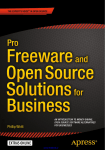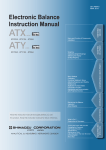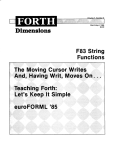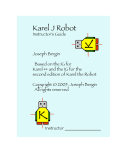Download phc Documentation
Transcript
phc Documentation
phc Documentation
The phc User’s Manual
The phc User’s Manual
Table of Contents
1. Introduction..........................................................................................................................................??
..........................................................................................................................................................??
2. Installation Instructions ......................................................................................................................??
System Requirements.......................................................................................................................??
PHP embed SAPI installation instructions ...................................................................................??
Installation Instructions....................................................................................................................??
3. Running phc .........................................................................................................................................??
Compiling executables .....................................................................................................................??
Compiling web applications.............................................................................................................??
Alternatives.............................................................................................................................??
Writing and Reading XML ..............................................................................................................??
Internal Representations...................................................................................................................??
Graphical Output..............................................................................................................................??
Including files...................................................................................................................................??
v
List of Figures
3-1. Abstract syntax tree for “Hello world”...............................................................................................??
vi
Chapter 1. Introduction
phc has supports limited code generation, and can be used as a front-end to parse PHP for other
applications. This manual explains how to compile, install and use phc, how to compile command-line
and web applications, and how to convert PHP to an XML reprentation, and back.
Note: Documentation of the phc API, including how to write plugins, can be found in The phc
Developer’s Manual.
The documentation for this and for older versions of phc can be found in the archive
(http://www.phpcompiler.org/src/archive/). Moreover, although we have tried to document phc as well as
we can, if anything is still unclear, please let us know by sending an email to the mailing list
(http://www.phpcompiler.org/mailinglist.html).
1
Chapter 2. Installation Instructions
System Requirements
Warning
These instructions only apply if you don’t intend to modify phc, and you are using
a downloaded phc release. If you intend to modify it, or you are using the phc
SVN repository (http://code.google.com/p/phc), please refer to the instructions for
developers.
phc needs a Unix-like environment to run (it has been tested on Linux, Solaris, FreeBSD, Cygwin and
Mac OS X). To compile phc, you will need:
•
g++ version 3.4.0 or higher
•
make
•
Boost version 1.34 or higher
•
PHP5 embed SAPI (version 5.2.x recommended; refer to PHP embed SAPI installation
instructions for more details). This is required to compile PHP code with phc.
•
Xerces-C++ (http://xml.apache.org/xerces-c/) if you want support for XML parsing (you don’t need
Xerces for XML unparsing).
•
Boehm garbage collector is used in phc, but not in code compiled by phc. If unavailable, it can be
disabled with --disable-gc, but phc will leak all memory it uses.
The following dependencies are optional:
•
a DOT viewer such as graphviz (http://www.graphviz.org) if you want to be able to view the graphical
output generated by phc (for example, syntax trees)
Under Debian/Ubuntu, the following command will install nearly all dependencies: apt-get
install build-essential libboost-dev libxerces27-dev graphviz
libgc-dev. You will still need to install the PHP embed SAPI manually.
PHP embed SAPI installation instructions
If you do not intend to compile PHP code using phc, you may skip this section.
In order to compile code, phc must have the PHP embed SAPI available, which is typically not available
via standard package managers. The embed SAPI is also required for compiling stand-alone executables.
2
Chapter 2. Installation Instructions
Download the PHP source (.tar.gz) package from php.net (http://www.php.net). We will assume you
downloaded PHP version 5.2.6, the latest version available at time of writing. To extract PHP,
tar zxvf php-5.2.6.tar.gz
This will create a new directory php-5.2.6. In order to configure and compile PHP, you must know
what configuration options you require. These are likely to be the same as the version of PHP you are
currently using, which can be examined with the command
php -i | grep Configure
We will assume these options are --enable-bcmath --with-gmp --with-mysql, a
configuration which we occasionally use for benchmarking. You are ready to build PHP. When
configuring, you must add the --enable-embed option.
CFLAGS="-O3" ./configure --enable-bcmath --with-gmp --with-mysql --enable-embed
make
If this command does not succeed, there is a problem with PHP on your system, and you should file a
bug report with the PHP group (http://bugs.php.net). (There is a known bug, and long work-around for
OSX already filed in the PHP bug system).
The most important part of the command is --enable-embed. While the CFLAGS="-O3"
environmental variable is optional, we find it speeds up the executable by about four times. If PHP is
already installed on your system, you may want to install this version separately, using the --prefix
option. Other configuration options are discussed in the developer manual. Finally, install the embed
SAPI:
make install
Installation Instructions
First of all, you must download (http://www.phpcompiler.org/downloads.html) the latest release of phc.
To extract phc,
tar zxvf phc-0.2.0.tar.gz
This will create a new directory phc-0.2.0 that contains the phc source tree. Finally, you must
compile phc. If the dependencies are in their standard locations, you should be able to simply type
cd phc-0.2.0
./configure
make
(Consult ./configure --help for configuration options, if your dependencies are not in standard
locations). This should compile without any warnings or errors. If this step fails, please send a bug report
to the mailing list (http://www.phpcompiler.org/mailinglist.html) with as much information about your
system as you can give, and we will try to resolve it. Finally, install phc using
make install
3
Chapter 2. Installation Instructions
For information on running phc, see Running phc. If you can follow those instructions and you get the
output you should get, congratulations! You have successfully installed phc.
4
Chapter 3. Running phc
Once you have installed phc (see Installation Instructions), run it by typing
phc --help
You should see
phc 0.2.0
Usage: phc [OPTIONS]... [FILES]...
-h, --help
--full-help
-V, --version
GENERAL OPTIONS:
-v, --verbose
-c, --compile
--pretty-print
--obfuscate
--run=STRING
--r-option=STRING
-d, --define=STRING
INPUT OPTIONS:
--read-xml=passname
--include
COMPILATION OPTIONS:
-C, --c-option=STRING
--extension=NAME
-O, --optimize=STRING
-o, --output=FILE
-e, --execute
PRETTY PRINTING OPTIONS:
--next-line-curlies
--no-leading-tab
--tab=STRING
Print help and exit
Print help, including hidden options, and exit
Print version and exit
Verbose output (default=off)
Compile (default=off)
Pretty print input according to the Zend style
guidelines (default=off)
Obfuscate input (default=off)
Run the specified plugin (may be specified multiple
times)
Pass option to a plugin (specify multiple flags in
the same order as multiple plugins - 1 option only
per plugin)
Define ini entry (only affects -c and --include)
Assume the input is in XML format. Start processing
after the named pass
Parse included or required files at compile-time
(default=off)
Pass option to the C compile (e.g., -C-g; can be
specified multiple times)
Generate a PHP extension called NAME instead of a
standalone application
Optimize (default=‘0’)
Place executable into file FILE
Run executable after compiling (implies -c)
(default=off)
Output the opening curly on the next line instead of
on the same line (default=off)
Don’t start every line in between with a
tab (default=off)
String to use for tabs while unparsing
(default=‘ ’)
5
Chapter 3. Running phc
--no-hash-bang
Do not output any #! lines
(default=off)
Now write a very small PHP script, for example
<? echo "Hello world!"; ?>
and save it to helloworld.php. Then run phc:
phc --pretty-print helloworld.php
This should output a pretty-printed version of your PHP script back to standard output:
<?php
echo "Hello world!";
?>
You can see a list of options controlling the style of pretty printing, using the --full-help option.
Compiling executables
phc can compile either executables or extensions. To compile an executable, phc creates C code, which
it compiles and links to the PHP embed SAPI. Since it links to PHP, you have access to all of PHP’s large
built-in standard library. In order to compile the "hello world" executable from before, run
phc -c helloworld.php -o helloworld
This creates an executable helloworld, which can then be run
./helloworld
If you prefer to run your executable immediately after it compiles, use the -e. phc will compile your
program, then immediately execute it. You can also view the C code generated by phc:
phc --generate-c helloworld.php > helloworld.c
One of the advantages of phc is that it can optimize your program. Using the -O flag, you can instruct
phc to analyse your source code, and perform simple optimizations. On simple benchmarks, this can
increase the speed of your application by 50%. To optimize:
phc -O2 -c helloworld.php -o helloworld
phc generates C code, which is then compiled by gcc. To see the command passed to gcc by phc, use
the -v flag.
If you specify the -O flag, phc will also pass the -O flag to gcc, which will optimize your code further.
The argument to the -O flag must therefore be usable by gcc, so it must be any of -O0 (default), -O1,
-O2, -O3 or -Os. Consult the gcc manual
(http://gcc.gnu.org/onlinedocs/gcc/Optimize-Options.html#Optimize-Options) for more details.
It is also possible to pass command-line arguments to gcc through phc, using the -C flag. For example,
to disable inlining of the generated code by gcc, using -fno-inline:
6
Chapter 3. Running phc
phc -c -O2 helloworld.php -o helloworld -C-fno-inline
Compiling web applications
Warning
In order to compile web applications, it is currently necessary to alter your php.ini
file, or have access to the root account. We welcome suggetions of a different
method which avoids these requirements, especially if they would work in a shared
hosting environment.
Warning
This section is experimental. Please report any problems
(http://www.phpcompiler.org/mailinglist.html).
We have created the command-line option --web-app, which will in the future automate the process of
compiling a web application. Unfortunately, for now, please follow these steps.
We describe how to create and install an extension using the C code generated by phc. While we give an
overview of creating extensions, significantly more detail can be found in the Zend Extension Writing
Tutorial (http://devzone.zend.com/node/view/id/1021) and in Extending and Embedding PHP
(http://www.amazon.com/dp/067232704X).
To begin, create a new directory for the extension. We’ll use ext/ in our example. Generate C code from
helloworld.php using phc.
phc --generate-c helloworld.php > ext/helloworld.c
Create a new file, ext/config.m4, by copying the following, and changing instances of "helloworld"
appropriately:
PHP_ARG_ENABLE(helloworld, whether to enable Hello World support,
[ --enable-helloworld
Enable Hello World support])
if test "$PHP_HELLOWORLD" = "yes"; then
AC_DEFINE(HAVE_HELLOWORLD, 1, [Whether you have Hello World])
PHP_NEW_EXTENSION(helloworld, helloworld.c, $ext_shared)
fi
In the previous section, we described using the PHP embed SAPI. If you installed a copy of PHP with
--enable-embed enabled, it is important NOT to use that version for the following commands.
Instead, you should the same version as your webserver uses. From the ext/ directory, run:
phpize --with-php-config=/usr/bin/php-config
./configure --enable-helloworld
Build and install the extension (if you dont have root, refer instead to Alternatives):
7
Chapter 3. Running phc
make
sudo make install
In your web folder, replace the existing helloworld.php file contents with the following:
<?php
dl ("helloworld.so");
__MAIN__ ();
?>
If the dl() function is not enabled in your php.ini file, enable it:
enable_dl = On;
Accessing helloworld.php should now work.
Alternatives
Instead of setting enable_dl, you can instead load the extension manually in your php.ini file:
extension=helloworld
You can also avoid installing the extension using sudo make install by adding an alternate
extension directory:
extensions_dir="/full/path/to/ext"
Writing and Reading XML
phc can output an XML representation of the PHP script. You can use this representation if you want to
process PHP scripts using tools in your desired framework, instead of using phc plugins. After
processing the XML representation, phc can convert it back into PHP. To generate an XML version of a
PHP script, run
./phc --dump-xml=ast helloworld.php > helloworld.xml
When reading the XML back in, all the usual features of phc are again available; in particular, it is
possible to read an XML file, and write PHP syntax. To convert the XML file we just generated back to
PHP syntax, run
./phc --read-xml=ast --pretty-print helloworld.xml
The generated XML should use the schema http://www.phpcompiler.org/phc-1.0. However, our XML
schema is currently broken.
8
Chapter 3. Running phc
Internal Representations
After parsing, phc converts a PHP script into an Abstract Syntax Tree (AST) (this is further explained in
Chapter 3 in The phc Developer’s Manual). This is very useful for processing PHP scripts which you
wish to convert back into PHP. However, for some tasks, especially program analysis, a simpler form of
the PHP script is more suitable. phc offers two other Internal Representations (IRs). The High-level
Internal Representation (HIR) simplifies most expressions by assigning them to temporary variables.
However, code represented in the HIR is still valid PHP. The Medium-level Internal Representation
(MIR) converts HIR statements to simpler components, for example converting control-flow statements
like the for-loop, into gotos. To view PHP in any of these forms, use the --dump option:
phc --dump=ast helloworld.php
phc --dump=hir helloworld.php
phc --dump=mir helloworld.php
Nearly all phc options work as well on the HIR and MIR as on the AST. For example, XML can be read
and written:
phc --dump-xml=hir | ./myprog | phc --read-xml=hir
Graphical Output
If you have a DOT viewer installed on your system (for example, graphviz (http://www.graphviz.org)),
you can view the AST graphically. First, ask phc to output the AST in DOT format:
./phc --dump-dot=ast helloworld.php > helloworld.dot
You can then view the tree (helloworld.dot) using Graphviz. In most Unix/Linux systems, you
should be able to do
dotty helloworld.dot
And you should see the tree; it should look similar to the tree shown in figure Figure 3-1.
9
Chapter 3. Running phc
Figure 3-1. Abstract syntax tree for “Hello world”
10
Chapter 3. Running phc
Including files
phc has initial support for compile-time processing of PHP’s include built-in. Enabling this feature
inserts the included statements in the AST in the place of the include statement. Included functions,
classes and interfaces become part of the file’s top-level scope. In the event that phc is not able to process
the include statement (for example, if the file cannot be found), a warning is issued, and the
include statement is left in place. To enable this support, run
./phc --include script_with_includes.php
The include support is intended to mimic PHP’s include built-in
(http://php.net/manual/en/function.include.php), as far as can be achieved at compile time. phc supports:
•
Moving included statements to the point at which include was called. Naturally, these statement’s
use the variable scope at the point at which they are included,
•
Preserving __FILE__ and __LINE__ statements,
•
Moving included functions to the %MAIN% class, and importing the included classes,
•
include, and require. If the specified file cannot be found, parsed, or if the argument to
include is not a string literal, the include statement is left in place.
phc does not support:
•
Return values in included scripts. We intend to support these in the future. They will likely be
supported in a later stage of the compilation process, instead of in the AST,
•
Calling include on anything other than a literal string containing the filename of a local file. This
excludes variables and remote files. These may be supported when more static analyses are available,
•
include_once and require_once, as we cannot guarantee that the file to be included is not
included elsewhere. These statements will not be processed, and combinations of include or
require and include_once or require_once may cause incorrect behaviour with this option
set,
•
Updating get_included_files() to reflect the included files.
11
The phc Developer’s Manual
The phc Developer’s Manual
Table of Contents
1. Introduction..........................................................................................................................................??
..........................................................................................................................................................??
System Requirements.......................................................................................................................??
Building PHP for phc development .................................................................................................??
Demonstration ..................................................................................................................................??
The Source Program ...............................................................................................................??
The Transform ........................................................................................................................??
The Result...............................................................................................................................??
Writing Plugins ................................................................................................................................??
Reference .........................................................................................................................................??
I. Tree Traversal API Tutorials...............................................................................................................??
2. Getting Started .............................................................................................................................??
................................................................................................................................................??
Compiling a Plugin.................................................................................................................??
About extern "C" .............................................................................................................??
Abstract Syntax ......................................................................................................................??
The Abstract Syntax Tree .......................................................................................................??
Working with the AST............................................................................................................??
Actually...................................................................................................................................??
Writing Stand Alone Applications .........................................................................................??
What’s Next? ..........................................................................................................................??
3. Traversing the Tree.......................................................................................................................??
................................................................................................................................................??
The Grammar (Revisited).......................................................................................................??
Statements and Expressions ...................................................................................................??
The Difficult Solution.............................................................................................................??
The Easy Solution...................................................................................................................??
Pre and Post Methods .............................................................................................................??
4. Modifying Tree Nodes .................................................................................................................??
................................................................................................................................................??
First Attempt...........................................................................................................................??
Modifying the Parameters ......................................................................................................??
Refactoring .............................................................................................................................??
What’s Next? ..........................................................................................................................??
5. Restructuring the Tree..................................................................................................................??
................................................................................................................................................??
Introducing the Tree_transform API..............................................................................??
The Implementation................................................................................................................??
Running Transformations .......................................................................................................??
A Subtlety...............................................................................................................................??
What’s Next? ..........................................................................................................................??
6. Using State ...................................................................................................................................??
................................................................................................................................................??
The Implementation................................................................................................................??
What’s Next? ..........................................................................................................................??
xiv
7. Modifying the Traversal Order.....................................................................................................??
................................................................................................................................................??
The Solution ...........................................................................................................................??
What’s Next? ..........................................................................................................................??
8. Returning Lists .............................................................................................................................??
................................................................................................................................................??
Deleting Nodes .......................................................................................................................??
Using the XML unparser ........................................................................................................??
The Full Transform.................................................................................................................??
What’s Next? ..........................................................................................................................??
II. Reference .............................................................................................................................................??
9. The Abstract Grammar.................................................................................................................??
................................................................................................................................................??
Overall Structure.....................................................................................................................??
Statements...............................................................................................................................??
Expressions.............................................................................................................................??
Additional Structure ...............................................................................................................??
Mix-in Code............................................................................................................................??
10. Representing PHP ......................................................................................................................??
................................................................................................................................................??
Variables .................................................................................................................................??
Comments...............................................................................................................................??
String parsing..........................................................................................................................??
elseif..................................................................................................................................??
Miscellaneous Other Changes ................................................................................................??
Comparison to the PHP grammar...........................................................................................??
11. Limitations .................................................................................................................................??
................................................................................................................................................??
Comments...............................................................................................................................??
Numbers .................................................................................................................................??
Scopes.....................................................................................................................................??
Other issues ............................................................................................................................??
12. Overview of the AST classes and transformation API ..............................................................??
................................................................................................................................................??
The AST classes .....................................................................................................................??
Deep Equality .........................................................................................................................??
Cloning ...................................................................................................................................??
Pattern Matching ....................................................................................................................??
The Visitor API.......................................................................................................................??
The Transform API.................................................................................................................??
13. Maketea Theory ......................................................................................................................??
Introduction ............................................................................................................................??
The Grammar Formalism .......................................................................................................??
Context Resolution .................................................................................................................??
Contexts ........................................................................................................................??
Reducing Contexts ........................................................................................................??
Resolution for Disjunctions ..........................................................................................??
xv
III. Development guide ............................................................................................................................??
14. Porting and Packaging................................................................................................................??
We need porters, packagers and maintainers..........................................................................??
Packaging hints.......................................................................................................................??
Test suite .................................................................................................................................??
phc packages ..........................................................................................................................??
xvi
List of Figures
1-1. Abstract syntax tree for the demo example ........................................................................................??
3-1. Abstract syntax tree for the running example ....................................................................................??
10-1. Function call in the AST ..................................................................................................................??
10-2. Function call as represented by PHP................................................................................................??
12-1. Sequence Diagram for the Visitor API.............................................................................................??
12-2. Sequence Diagram for the Transform API .......................................................................................??
xvii
Chapter 1. Introduction
From the start, one of the design goals of phc has been to provide a useful framework for writing
applications that process PHP scripts. phc parses PHP code into an internal representation known as an
abstract syntax tree or AST. Applications can process PHP code by analysing and modifying this abstract
representation in one of two ways:
•
phc supports plugins. Plugins are modules that can be loaded into phc, which get access to the AST.
phc provides sophisticated support for writing operations over the AST through the Tree
Transformation API.
•
Alternatively, you can export the AST to XML. You can then process the XML in any way you like,
and then use phc to convert the XML back to PHP.
The Tree Traversal API Tutorials explain how to write plugins for phc, and provide numerous examples.
You will find Reference very useful when writing serious applications using phc.
Although we have tried to document phc as well as we can, if anything is still unclear, please let us know
by sending an email to the mailing list (http://www.phpcompiler.org/mailinglist.html).
System Requirements
If you want to modify the internals of phc in other ways than through the explicit API we provide for
doing so, you will following tools listed below, in addition to those detailed in the user manual (Chapter
2 in The phc User’s Manual). However, most people should not need these tools (even if you are
implementing tools based on phc).
•
flex if you need to modify the lexical analyser
•
bison if you need to modify the parser
•
maketea (http://www.maketea.org) if you want to modify the phc grammars (or the AST/HIR/MIR
classes)
•
gengetopt (http://www.gnu.org/software/gengetopt/gengetopt.html) if you need to add additional
command line arguments; you will need version 0.20 or higher
•
gperf (http://www.gnu.org/software/gperf/gperf.html) if you need to modify the list of keywords
recognized by the lexical analyser
Building PHP for phc development
When compiling PHP for use with phc, there are a few options:
•
Development: For developing phc or debugging phc problems, it is worthwhile to have debugging
symbols and leak checkers enabled.
1
Chapter 1. Introduction
CFLAGS="-O0 -ggdb3" ./configure --enable-debug
--enable-maintainer-zts --enable-embed
•
Deployment: For performance, optimization should be used:
CFLAGS="-O3 -g" ./configure --enable-embed
•
Benchmarking: In order to be fair, both phc-generated-code and PHP should be compiled with -O3.
The are also some options required to run some benchmarks. The prefix is supplied to correspond to
benchmarking scripts we provide:
CFLAGS="-O3 -DNDEBUG" ./configure --enable-embed --enable-bcmath
--with-gmp --prefix=/usr/local/php-opt
Demonstration
This section is intended as a quick introduction outlining what the current release of phc can do for you.
It does not explain everything in detail.
The Source Program
Consider the following simple PHP script.
<?php
function foo()
{
return 5;
}
$foo = foo();
echo "foo is $foo<br>";
?>
Internally this program gets represented as an abstract syntax tree, as shown in figure Figure 1-1.
2
Chapter 1. Introduction
Figure 1-1. Abstract syntax tree for the demo example
3
Chapter 1. Introduction
The Transform
Suppose we want to rename function foo to bar. This is done by the following plugin:
#include "AST_visitor.h"
#include "pass_manager/Plugin_pass.h"
class Rename_foo_to_bar : public Visitor
{
void pre_method_name(METHOD_NAME* in)
{
if(*in->value == "foo")
in->value = new String("bar");
}
};
extern "C" void run_ast (AST::PHP_script* in, Pass_manager* pm, String* option)
{
Rename_foo_to_bar f2b;
php_script->visit(&f2b);
}
extern "C" void load (Pass_manager* pm, Plugin_pass* pass)
{
pm->add_after_named_pass (pass, new String("ast"));
}
The Result
Running phc gives
<?php
function bar()
{
return 5;
}
$foo = bar();
echo "foo is " . $foo . "<br>";
?>
where the name of the function has been changed, while the name of the variable remained unaltered, as
has the text "foo" inside the string. It’s that simple! Of course, in this example, it would have been
quicker to do it by hand, but that’s not the point; the example shows how easy it is to operate on PHP
scripts within the phc framework.
4
Chapter 1. Introduction
Writing Plugins
Getting Started introduces writing plugins for phc. It then explains how phc represents PHP scripts
internally, and shows how to write a first (but ultimately wrong) attempt at simple plugin that counts the
number of statements in a PHP script.
Traversing the Tree introduces the support that phc offers for traversing (and transforming) scripts. It
shows how to write a plugin that correctly counts the number of statements in a script.
Modifying Tree Nodes shows how you can modify nodes in the tree (without modifying the structure of
the tree). It shows how to replace calls to mysql_connect by calls to dbx_connect.
Restructuring the Tree shows how you can modify the structure of the tree. It works through an example
that removes unnecessary string concatenations (for example, $a . "" is replaced by just $a).
Using State explains an advanced features of pattern matching, and shows an important technique: the
use of state in transformations (where one transformation depends on a previous transformation). It
shows how to write a program that renames all functions foo in a script to db_foo, if there are calls to
a database engine within foo.
Modifying the Traversal Order explains how to change the order in which the children of a node are
visited, avoid visiting some children, or how to execute a piece of code in between visiting two children.
Returning Lists shows how to define transformations that replace nodes in the tree by multiple other
nodes, and how to delete nodes from the tree. It also shows to call the phc parser and unparsers from
plugins.
Reference
phc represents PHP scripts internally as an abstract syntax tree. The structure of this tree is dictated by
the The Abstract Grammar. The grammar definition is a very important part of phc.
phc’s view on the world (as dictated by the grammar) does not completely agree with the PHP standard
view. Representing PHP describes how the various PHP constructs get translated into the abstract syntax.
Overview of the AST classes and transformation API gives an overview of the AST classes, the tree
visitor API and the tree transformation API from a programmer’s perspective.
Maketea is a tool bundled with phc which, based on a grammar definition of a language, generates a
C++ hierarchy for the corresponding abstract syntax tree, a tree transformation and visitor API, and deep
cloning, deep equality and pattern matching on the AST. Maketea Theory explains some of the theory
behind maketea; in particular, the grammar formalism, the mapping from the grammar to the AST
classes, and the derivation of the tree transformation API.
5
I. Tree Traversal API Tutorials
Chapter 2. Getting Started
For this introductory tutorial, we assume that you have successfully downloaded and installed phc, and
that you know how to run it (Chapter 2 in The phc User’s Manual and Chapter 3 in The phc User’s
Manual). This tutorial gets you started with using phc to develop your own tools for PHP by writing
plugins.
Compiling a Plugin
To get up and running, we’ll first write a “hello world” plugin that does nothing except print a string.
Create a new directory, say ~/myplugins and create a new file helloworld.cpp:
#include <AST.h>
#include <pass_manager/Plugin_pass.h>
extern "C" void load (Pass_manager* pm, Plugin_pass* pass)
{
pm->add_after_named_pass (pass, new String ("ast"));
}
extern "C" void run_ast (AST::PHP_script* in, Pass_manager* pm, String* option)
{
cout << "Hello world (I’m a phc plugin!)" << endl;
}
This is an example of an (almost) minimal plugin. Every plugin you write must contain these functions,
with these exact signatures. load is run when phc starts, giving your plugin the opportunity to add itself
to the list of passes phc runs. In this example, it is added after the "ast" pass. When phc processes a PHP
script, it runs all of the passes on it in turn. When it’s your plugin’s turn, it calls your version of
run_ast.
To compile the plugin, run
~/myplugins$ phc_compile_plugin helloworld.cpp
(phc_compile_plugin is a small shellscript that makes the task of compiling plugins easier; it calls
g++ in a platform independent way; if you’re curious, you can open it in any text editor.) Finally, run the
plugin using
~/myplugins$ phc --run helloworld.la sometest.php
(You need to pass in an input script to phc even though our plugin does not use it.) If that worked as
expected, congratulations: you’ve just written your first phc plugin! :-)
2
Chapter 2. Getting Started
About extern "C"
You may have been wondering what the extern "C" in the definition of load and run_ast is for;
the reason is that phc uses the libtool’s libltdl interface to load your plugin; if the functions are
not declared as extern "C", phc will not be able to find them in your plugin because the name of that
function will have been mangled by the C++ compiler. It does not mean that you cannot write C++ code
inside these functions.
If you don’t understand any of that, don’t worry about it: just remember that you need to declare load,
run_ast, and a small number of other functions which we’ll name later, as extern "C" and
everything will be fine. (You don’t need extern "C" for any functions you might define).
Abstract Syntax
To be able to do anything useful in your plugins, you need to know how phc represents PHP code
internally. phc’s view of PHP scripts is described by an abstract grammar. An abstract grammar
describes how the contents of a PHP script are structured. A grammar consists of a number of rules. For
example, there is a rule in the grammar that describes how if statements work:
If ::= Expr iftrue:Statement* iffalse:Statement* ;
This rules reads: “An if statement consists of an expression (the condition of the if-statement), a list of
statements called ‘iftrue’ (the instructions that get executed when the condition holds), and another list
of statements called ‘iffalse’ (the instructions that get executed when the condition does not hold)”. The
asterisk (*) in the rule means “list of”.
As a second example, consider the rule that describes arrays in PHP. This rule should cover things such
as array(), array("a", "b") and array(1 => "a", 2 => "g"). Arrays are described
by the following two rules.
Array ::= Array_elem* ;
Array_elem ::= key:Expr? val:Expr ;
(Actually, this is a simplification, but it will do for the moment.) These two rules say that “an array
consists of a list of array elements”, and an “array element has an optional expression called ‘key’, and a
second expression called ‘val’”. The question mark (?) means “optional”. Note that the grammar does
not record the need for the keyword array, or for the parentheses and commas. We do not need to
record these, because we already know that we are talking about an array; all we need to know is what
the array elements are.
The Abstract Syntax Tree
When phc reads a PHP script, it builds up an internal representation of the script. This representation is
known as an abstract syntax tree (or AST for short). The structure of the AST follows directly from the
abstract grammar. For people familiar with XML, this tree can be compared to the DOM representation
of an XML script (and in fact, phc can output the AST as an XML document, see Chapter 3 in The phc
User’s Manual).
3
Chapter 2. Getting Started
For example, consider if-statements again. An if-statement is represented by an instance of the If
class, which is (approximately) defined as follows.
class If
{
public:
Expr* expr;
Statement_list* iftrue;
Statement_list* iffalse;
};
Thus, the name of the rule (if ::= ...) translates into a class If, and the elements on the right hand
side of the rule (Expr iftrue:Statement* iffalse:Statement*) correspond directly to the
class members. The class Statement_list inherits from the STL list class, and can thus be
treated as such.
Similarly, the class definitions for arrays and array elements look like
class Array
{
public:
Array_elem_list* array_elems;
};
class Array_elem
{
public:
Expr* key;
Expr* val;
};
When you start developing applications with phc you will find it useful to consult the full description of
the grammar, which can be found in Chapter 9. A detailed explanation of the structure of this grammar,
and how it converts to the C++ class structure, can be found in Chapter 13. Some notes on how phc
converts normal PHP code into abstract syntax can be found in Chapter 10.
Working with the AST
When you want to build tools based on phc, you do not have to understand how the abstract syntax tree
is built, because this is done for you. Once the tree has been built, you can examine or modify the tree in
any way you want. When you are finished, you can ask phc to output the tree to normal PHP code again.
Let’s write a very simple plugin that counts the number of statements in a script. Create a new file
~/myplugins/count_statements.cpp. Recall the skeleton plugin:
#include <AST.h>
#include <pass_manager/Plugin_pass.h>
extern "C" void load (Pass_manager* pm, Plugin_pass* pass)
{
pm->add_after_named_pass (pass, new String ("ast"));
4
Chapter 2. Getting Started
}
extern "C" void run_ast (AST::PHP_script* in, Pass_manager* pm, String* option)
{
}
You will notice that run_ast gets passed an object of type PHP_script. This is the top-level node of
the generated AST. If you look at the grammar (Chapter 9), you will find that PHP_script
corresponds to the following rule:
PHP_script ::= Statement* ;
Thus, as far as phc is concerned, a PHP script consists of a number of statements. The class
PHP_script will have therefore have one member, called statements, the list of statements. So, to
count the number of classes, all we have to do is query the number of elements in the statements list:
#include <AST.h>
#include <pass_manager/Plugin_pass.h>
extern "C" void load (Pass_manager* pm, Plugin_pass* pass)
{
pm->add_after_named_pass (pass, new String ("ast"));
}
extern "C" void run_ast (AST::PHP_script* in, Pass_manager* pm, String* option)
{
printf("%d statement(s) found\n", in->statements->size());
}
Save this file to ~/myplugins/count_statements.cpp. Compile:
~/myplugins$ phc_compile_plugin count_statements.cpp
And run:
./phc --run count_statements.la hello.php
Actually..
If you actually did try to run your plugin, you may have found that our plugin isn’t quite correct.
Consider the following example:
<?php
$x = 5;
if($x == 5)
echo "yes";
else
echo "no";
?>
5
Chapter 2. Getting Started
If you run our plugin on this example, if will report two statements. Why? Well, the first statement is the
assignment, and the second is the conditional (the if statement). The statements inside the if statement
are not counted, because they are not part of the outer list of statements of the script. In the next tutorial
we will see how to fix this.
Writing Stand Alone Applications
If you prefer not to write a plugin but want to modify phc itself to derive a new, stand-alone, application,
you can add your passes in src/phc.cpp in the phc source tree instead. This has the effect of
“hardcoding” your plugin into phc (in versions before 0.1.7, this was the only way to write extensions).
However, in the rest of the tutorials we will assume that you are writing your extension as a plugin.
What’s Next?
In theory, you now know enough to start implementing your own tools for PHP. Write a new plugin, run
the plugin using the --run option, and optionally pass in the --pretty-print option also to
request that phc outputs the tree back to PHP syntax after having executed your plugin.
However, you will probably find that modifying the tree, despite being well-defined and easy to
understand, is actually rather laborious. It requires a lot of boring boilerplate code. The good news is that
phc provides sophisticated support for examining and modifying this tree. This is explained in detail in
the follow-up tutorials.
6
Chapter 3. Traversing the Tree
In Chapter 2, we explained that phc represents PHP scripts internally as an abstract syntax tree, and that
the structure of this tree is determined by the The Abstract Grammar. We then showed how to make use
of this tree to count the number of statements. However, the plugin we wrote only counted the
“top-level” statements. Statements nested inside other statements (for example, statements inside the true
or false branch of an if statement) were ignored. In this tutorial, we will rectify this problem and write a
plugin that counts all statements in a script. So, for
<?php
$x = 5;
if($x == 5)
echo "yes";
else
echo "no";
?>
we should report four statements.
Note that all the plugins that we will develop in these tutorials are included in the phc distribution. For
example, in this tutorial we will be developing two plugins: a difficult solution to the problem and an
easy solution to the problem. You can run these plugins by running
phc --run plugins/tutorials/count_statements_difficult.la test.php
or
phc --run plugins/tutorials/count_statements_easy.la test.php
The Grammar (Revisited)
How do we go about counting all statements in a script? Remember that, as far as phc is concerned, a
PHP script consists of a number of statements, but some of those statements may have other statements
nested inside them. Here is part of the phc grammar:
PHP_script ::= Statement* ;
Statement ::= Eval_expr | If | While | ...
If ::= Expr iftrue:Statement* iffalse:Statement* ;
While ::= Expr Statement* ;
The vertical bar (|) means “or”. So, a statement is either an evaluation of an expression (eval_expr),
an if statement, or a while statement, or.. Thus, our running example is represented by the tree in
Figure 3-1. The four statements that we are interested in have been highlighted.
7
Chapter 3. Traversing the Tree
Figure 3-1. Abstract syntax tree for the running example
8
Chapter 3. Traversing the Tree
Statements and Expressions
The Eval_expr nodes in the tree probably need some explanation. There are many different types of
statements in PHP: if-statements, while-statements, for-loops, etc. You can find the full list in the
The Abstract Grammar. If you do look at the grammar, you will notice in particular that a function call is
not actually a statement! Instead, a function call is an expression.
The difference between statements and expressions is that a statement does something (for example, a
for-loop repeats a bunch of other statements), but an expression has a value. For example, “5” is an
expression (with value 5), “1+1” is an expression (with value 2), etc. A function call is also considered
an expression. The value of a function call is the value that the function returns.
Now, an eval_expr makes a statement from an expression. So, if you want to use an expression where
phc expects a statement, you have to use the grammar rule
Statement ::= ... | Eval_expr ;
Eval_expr ::= Expr ;
The Difficult Solution
The following plugin is a partial solution to counting the number of statements in a tree. If you do not
understand the code, do not worry! We will look at a much easier solution in a second. If you understand
the comments, that is enough.
#include <AST.h>
#include <pass_manager/Plugin_pass.h>
int count(AST::Statement_list* in)
{
// Every item in "in" is a statement
int num_statements = in->size();
// But there can also be statements nested inside any
// of the statements in "in". We consider each one in turn.
Statement_list::const_iterator i;
for(i = in->begin(); i != in->end(); i++)
{
// Check if the statement is an if-statement
if(If* if_stmt = dynamic_cast<If*>(*i))
{
num_statements += count(if_stmt->iftrue);
num_statements += count(if_stmt->iffalse);
}
}
return num_statements;
}
extern "C" void load (Pass_manager* pm, Plugin_pass* pass)
{
pm->add_after_named_pass (pass, new String ("ast"));
9
Chapter 3. Traversing the Tree
}
extern "C" void run_ast (AST::PHP_script* in, Pass_manager* pm, String* option)
{
int num_statements = count(in->statements);
cout << num_statements << " statements found" << endl;
}
The overall structure of this plugin should be fairly clear. We count all the statements in the outermost
list of statements, and then consider each statement in turn to check if there are any statements nested
inside them. This plugin will now report the correct number of statements for our example with the if
statement. However, if will report an invalid number of statements for examples with other types of
statements. For example, it will report only two statements for
<?php
$x = 5;
while($x--)
{
echo $x;
}
?>
Of course, we can fix the plugin by testing for while statements. And for do statements. And for
foreach, switch, try, etc. As mentioned, manually dealing with the syntax tree is a laborious
process! Even something as simple as counting the number of statements in a script becomes a large
program. Fortunately, there is a much easier solution.
The Easy Solution
Fortunately, phc will do all this for you automatically! There is a standard “do-nothing” tree traversal
predefined in phc in the form of a class called AST::Visitor (defined in AST_visitor.h).
AST::Visitor contains methods for each type of node in the tree. phc will automatically traverse the
abstract syntax tree for you, and call the appropriate method at each node.
In fact, there are two methods defined for each type of node. The first method, called pre_something,
gets called on a node before phc visits the children of the node. The second method, called
post_something, gets called on a node after phc has visited the children of the node. For example,
pre_if gets called on an If, before visiting the statements in the iftrue and iffalse clauses of
the If. After all the statements, have been visited, post_if gets called.
So, here is an alternative and much easier solution for our problem. This plugin will actually count all
statements in a script, without having to worry about all the different ways statements can be embedded
in other statements. Moreover, even if the internal representation of phc changes (for example, if another
type of statement gets added), this plugin will still work as-is.
#include "AST_visitor.h"
#include <pass_manager/Plugin_pass.h>
class Count_statements : public AST::Visitor
{
10
Chapter 3. Traversing the Tree
private:
int num_statements;
public:
// Set num_statements to zero before we begin
void pre_php_script(AST::PHP_script* in)
{
num_statements = 0;
}
// Print the number of function calls when we are done
void post_php_script(AST::PHP_script* in)
{
cout << num_statements << " statements found" << endl;
}
// Count the number of function calls
void post_statement(AST::Statement* in)
{
num_statements++;
}
};
extern "C" void load (Pass_manager* pm, Plugin_pass* pass)
{
pm->add_after_named_pass (pass, new String ("ast"));
}
extern "C" void run_ast (AST::PHP_script* in, Pass_manager* pm, String* option)
{
Count_statements cfc;
in->visit(&cfc);
}
We override a number of methods of the Visitor class to implement the functionality we need; the
traversal is then taken care of by phc.
Pre and Post Methods
We need to be precise about the order in which phc calls all these methods. Suppose we have a node Foo
(say, an if-statement), which is-a Bar (say, statement), which itself is-a Baz (say, commented node).
Then phc calls the visitor methods in the following order:
1. pre_baz
2. pre_bar
3. pre_foo
4. children_foo (visit the children of foo)
5. post_foo
11
Chapter 3. Traversing the Tree
6. post_bar
7. post_baz
Just to emphasise, if all of the visitor methods listed above are implemented, they will all be invoked, in
the order listed above. So, implementing a more specific visitor (pre_foo) does not inhibit the more
general method (pre_bar) from being invoked. You can run the
plugins/tutorials/show_traversal_order.la from the phc distribution to see this in action.
Note: (Advanced users) As mentioned above, if you implement pre_if (say), the more general
methods such as pre_statement or pre_node will still be invoked. It is possible to override
pre_if_chain instead; if you override pre_if_chain, you are responsible for calling the more
general methods manually. If you don’t, they will not be called at all.
12
Chapter 4. Modifying Tree Nodes
Now that we have seen in Chapter 3 how to inspect the tree, in this tutorial we will look at modifying the
tree. The task we set ourselves is: replace all calls to mysql_connect by calls to dbx_connect
(dbx (http://pecl.php.net/package/dbx) is a PECL extension to PHP that allows scripts interface with a
database independent of the type of the database; this conversion could be part of a larger refactoring
process that makes a script written for MySQL work with other databases.)
The tutorial we develop in this tutorial is available as MySQL2DBX.la in the phc distribution. To see its
effect, run phc as follows:
phc --run plugins/tutorials/MySQL2DBX.la --pretty-print test.php
First Attempt
We are interested in all function calls to mysql_connect. Let us have a look at the precise definition
of a function call according to the The Abstract Grammar:
Method_invocation ::= Target? Method_name Actual_parameter* ;
Method_name ::= METHOD_NAME | Reflection ;
Actual_parameter ::= is_ref:"&"? Expr ;
Reflection ::= Expr ;
(The target of a method invocation is the class or object the function gets invoked on, if any. It need
not worry us here.) For now, we are only interested in the Method_name. The grammar tells us that a
Method_name is either a METHOD_NAME or a node of type Reflection. If a symbol is written in
CAPITALS in the grammar, that means it refers to a “token”, a literal value. In this case, to an actual
method name (such as mysql_connect). In PHP, it is also possible to call a method whose name is
stored in variable; in this case, the function name will be a Reflection node (which contains an
Expr). In this tutorial, we are interested in “normal” method invocations only.
All tokens have an attribute called value which corresponds to the value of the token. For most tokens,
the type of value is a String* (consider a String to be an STL string. However, for some
tokens, for example INT, value has a different type (e.g., int). If the token has a non-standard type, it
will have method called get_source_rep, which returns a String* representing the token in the
source. For example, the real number 5E-1 would have value equal to the (double) 0.5, but
get_source_rep would return (the String*) “5E-1”.
Thus, we arrive at the following first attempt.
#include "AST_visitor.h"
#include <pass_manager/Plugin_pass.h>
using namespace AST;
class MySQL2DBX : public Visitor
{
public:
13
Chapter 4. Modifying Tree Nodes
void post_method_invocation(Method_invocation* in)
{
if(in->method_name->match(new METHOD_NAME(new String("mysql_connect"))))
{
// Modify name
in->method_name = new METHOD_NAME(new String("dbx_connect"));
}
}
};
extern "C" void load (Pass_manager* pm, Plugin_pass* pass)
{
pm->add_after_named_pass (pass, new String ("ast"));
}
extern "C" void run_ast (PHP_script* in, Pass_manager* pm, String* option)
{
MySQL2DBX m2d;
in->visit(&m2d);
}
Note: phc uses a garbage collector, so there is never any need to free objects (you never have to
call delete). This makes programming much easier and less error-prone (smaller chance of bugs).
match compares two (sub)trees for deep equality. There is also another function called deep_equals,
which does nearly the same thing, but there are two important differences. match does not take
comments, line numbers and other “additional” information into account, whereas deep_equals does.
The second difference is that match supports wildcards; this will be explained in Chapter 5.
Modifying the Parameters
Unfortunately, renaming mysql_connect to dbx_connect is not sufficient, because the parameters
to the two functions differ. According to the PHP manual (http://www.php.net/manual/en/index.php), the
signatures for both functions are
mysql_connect (server, username, password, new_link, int client_flags)
and
dbx_connect (module, host, database, username, password, persistent)
The module parameter to dbx_connect should be set to DBX_MYSQL to connect to a MySQL
database. Then host corresponds to server, and username and password have the same purpose
too. So, we should insert DBX_MYSQL at the front of the list, and insert NULL in between host and
username (the mysql_connect command does not select a database). The last two parameters to
mysql_connect do not have an equivalent in dbx_connect, so if they are specified, we cannot
perform the conversion. The last parameter to dbx_connect (persistent) is optional, and we will
ignore it in this tutorial.
14
Chapter 4. Modifying Tree Nodes
Now, in phc, DBX_MYSQL is a Constant, which has two fields, an optional class name (for class
constants) and the name of the constant, of type CONSTANT_NAME. NULL is represented by NIL (to
avoid getting confused with the C++ value NULL.
We are now ready to write our conversion function:
#include "AST_visitor.h"
#include <pass_manager/Plugin_pass.h>
using namespace AST;
class MySQL2DBX : public Visitor
{
public:
void post_method_invocation(Method_invocation* in)
{
Actual_parameter_list*>::iterator pos;
CONSTANT_NAME* module_name;
Constant* module_constant;
Actual_parameter* param;
if(in->method_name->match(new METHOD_NAME(new String("mysql_connect"))))
{
// Check for too many parameters
if(in->actual_parameters->size() > 3)
{
printf("Error: unable to translate call "
"to mysql_connect on line %d\n", in->get_line_number());
return;
}
// Modify name
in->method_name = new METHOD_NAME(new String("dbx_connect"));
// Modify parameters
module_name = new CONSTANT_NAME(new String("DBX_MYSQL"));
module_constant = new Constant(NULL, module_name);
pos = in->actual_parameters->begin();
param = new Actual_parameter(false, module_constant);
in->actual_parameters->insert(pos, param); pos++;
/* Skip host */ pos++;
param = new Actual_parameter(false, new NIL());
in->actual_parameters->insert(pos, param);
}
}
};
extern "C" void load (Pass_manager* pm, Plugin_pass* pass)
{
pm->add_after_named_pass (pass, new String ("ast"));
}
15
Chapter 4. Modifying Tree Nodes
extern "C" void run_ast (PHP_script* in, Pass_manager* pm, String* option)
{
MySQL2DBX m2d;
in->visit(&m2d);
}
If we apply this transformation to
$link = mysql_connect(’host’, ’user’, ’pass’);
We get
$link = dbx_connect(DBX_MYSQL, "host", NULL, "user", "pass");
Refactoring
A quick note on refactoring. Refactoring is the process of modifying existing programs (PHP scripts),
usually to work in new projects or in different setups (for example, with a different database engine).
Manual refactoring is laborious and error-prone, so tool-support is a must. Although phc can be used to
refactor PHP code as shown in this tutorial, a dedicated refactoring tool for PHP would be easier to use
(though of course less flexible). Such a tool can however be built on top of phc.
What’s Next?
Chapter 5 explains how you can modify the structure of the tree, as well as the tree nodes.
16
Chapter 5. Restructuring the Tree
Now that we have seen in Chapter 3 how we can traverse the tree, and in Chapter 4 how we can modify
individual nodes in the tree, in this tutorial we will look at modifying the structure of the tree itself.
The transform that we will be considering in this tutorial is one that is used in phc itself. The transform is
called Remove_concat_null and can be found in src/process_ast/Remove_concat_null.h.
The purpose of the transform is to remove string concatenation with the empty string. For example,
<?php
$s = "foo" . "";
?>
is translated to
<?php
$s = "foo";
?>
The reason that this transform is implemented in phc is due to how the phc parser deals with in-string
syntax. For example, if you write
$a = "foo $b bar";
the corresponding tree generated by phc is
$a = "foo " . $b . " bar";
In other words, the variables are pulled out of the string, and the various components are then
concatenated together. However, taken to its logical conclusion, that means that if you write
$a = "foo $b";
the parser generates
$a = "foo " . $b . "";
Obviously, the second concatenation is unnecessary, and the Remove_concat_null transform cleans
this up. In this tutorial we will explain how this transform can be written.
Introducing the Tree_transform API
Concatenation is a binary operator, so we are interested in nodes of type Bin_op. If you check the
grammar, or, alternatively, src/generated/AST.h, you will find that Bin_op has three attributes: a
left and a right expression (of type Expr) and the operator itself (OP* op). Thus, we are
interested in nodes of type Bin_op whose op equals the single dot (for string concatenation).
Based on the previous two tutorials, we might try something like this:
17
Chapter 5. Restructuring the Tree
class Remove_concat_null : public Visitor
{
public:
void pre_bin_op(Bin_op* in)
{
// Find concat operators
if(*in->op->value == ".")
{
// ...
}
}
}
The problem is, what are we going to do inside the if? Tree visitors can only inspect and modify *in;
they cannot restructure the tree. In particular, we cannot replace *in by a new node. For this purpose,
phc offers a separate API, the tree transformation API. It looks very similar to the tree visitor API, but
there are two important differences. First, the pre and post methods can modify the structure of the
tree by returning new nodes. Second, there are no “generic” methods in the tree transform API. So, it is
not possible to define a transformation that would replace all statements by something else. (It is not
clear how that would be useful, anyway.)
So, we need to write our transformation using the Tree_transform API, defined in
AST_transform.h. Restructuring the class above yields
class Remove_concat_null : public Transform
{
public:
Expr* pre_bin_op(Bin_op* in)
{
// Find concat operators
if(*in->op->value == ".")
{
// ...
}
}
}
The differences between the previous version have been highlighted. We inherit from a different class,
and pre_bin_op now has a return value, which is the node that will replace *in. If you check the
default implementation of pre_bin_op in AST_transform.cpp, you’ll find:
Expr* Transform::pre_bin_op(Bin_op* in)
{
return in;
}
The return in; is very important; as we mentioned before, the return value of pre_bin_op will
replace *in in the tree. Therefore, if we don’t want to replace *in, or perhaps if we want to replace
*in only if a particular condition holds, we must return in. This will replace *in by in itself.
The second thing to note is that the return type of pre_bin_op is Expr instead of Bin_op. This
means that we can replace a binary operator node by another other expression node. The Maketea Theory
18
Chapter 5. Restructuring the Tree
explains exactly how the signatures for the pre and post methods are derived, but in most cases they
are what you’d expect. The easiest way to check is to simply look them up in <AST_transform.h>.
The Implementation
We wanted to get rid of useless concatenation operators. To be precise, if the binary operator is the
concatenation operator, and the left operand is the empty string, we want to replace the node by the right
operand; similarly, if the right operand is the empty string, we want to replace the operator by its left
operand. Here’s the full transform:
class Remove_concat_null : public Transform
{
public:
Expr* post_bin_op(Bin_op* in)
{
STRING* empty = new STRING(new String(""));
Wildcard<Expr>* wildcard = new Wildcard<Expr>;
// Replace with right operand if left operand is the empty string
if(in->match(new Bin_op(empty, wildcard, ".")))
return wildcard->value;
// Replace with left operand if right operand is the empty string
if(in->match(new Bin_op(wildcard, empty, ".")))
return wildcard->value;
return in;
}
}
We already explained what match does in Chapter 4, but we have not yet explained the use of
wildcards. If you are using a wildcard (WILDCARD) in a pattern passed to match, match will not take
that subtree into account. Thus,
if(in->match(new Bin_op(empty, WILDCARD, ".")))
can be paraphrased as “is in a binary operator with the empty string as the left operand and "." as the
operator (I don’t care about the right operand)?“ If the match succeeded, you can find out which
expression was matched by the wildcard by accessing wildcard->value.
Running Transformations
Recall from the previous two tutorials that visitors are run with a call to visit:
extern "C" void run_ast (PHP_script* in, Pass_manager* pm, String* option)
{
SomeVisitor visitor;
in->visit(&visitor);
19
Chapter 5. Restructuring the Tree
}
Likewise, transformations are run with a call to transform_children:
extern "C" void run_ast (PHP_script* in, Pass_manager* pm, String* option)
{
SomeTransform transform;
in->transform_children(&transform);
}
We invoke transform_children because we should not replace the top-level node in the AST (the
PHP_script node itself).
A Subtlety
If you don’t understand this section right now, don’t worry about it; you might find it useful to read it
again after having gained some experience with the transformation API.
We have implemented the transform as a post-transform rather than a pre- transform. Why? Suppose we
implemented the transform as a pre-transform. Consider the following PHP expression (bracketed
explicitly for emphasis:)
("" . $a) . ""
The first binary operator we encounter is the second one (get phc to print the tree if you don’t see why.)
So, we apply the transform and replace the operator by its left operand, which happens to be ("" .
$a). We then continue and transform the children of the that node, because that is how the tree
transform API is defined. But the children of that node are "" and $a. So, that means that the other
binary operator itself will never be processed!
There are two solutions to this problem. The first is the one we used above, and use a post-transform
instead of a pre-transform. You should try to reason out why this works, but a rule of thumb is that unless
there is a good reason to use a pre-transform, it’s safer to use the post-transform, because in the
post-transform the children of the node have already been transformed, so that you are looking at the
“final” version of the node.
The second solution is to use a pre-transform, but explicitly tell phc to transform the new node in turn.
This is the less elegant solution, but sometimes this is the only solution that will work (see for example
the Token_conversion transform in the src/process_ast/Token_conversion.cpp). To do
this, you would replace
return in->right;
by
return in->right->pre_transform(this);
20
Chapter 5. Restructuring the Tree
What’s Next?
The next tutorial in this series, Using State, introduces a very important notion in transforms: the use of
state.
21
Chapter 6. Using State
This tutorial explains an advanced feature of pattern matching, and shows an important technique in
writing tree transforms: the use of state. Suppose we are continuing the refactoring tool that we began in
Chapter 4, and suppose that we have replaced all calls to database specific functions by calls to the
generic DBX functions. To finish the refactoring, we want to rename any function foo in the script to
foo_DB, if it makes use of the database — this clearly sets functions that use the database apart, which
may make the structure of the script clearer.
So, we want to write a transform that renames all functions foo to foo_DB, if there is one or more call
within that function to any dbx_something function. Here is a simple example:
<?php
function first()
{
global $link;
$error = dbx_error($link);
}
function second()
{
echo "Do something else";
}
?>
After the transform, we should get
<?php
function first_DB()
{
global $link;
$error = dbx_error($link);
}
function second()
{
echo "Do something else";
}
?>
The Implementation
Since we have to modify method (function) names, the nodes we are interested in are the nodes of type
Method. However, how do we know when to modify a particular method? Should we search the method
body for function calls to dbx_xxx? As we saw in Chapter 3, manual searching through the tree is
cumbersome; there must be a better solution.
22
Chapter 6. Using State
The solution is in fact very easy. At the start of each method, we set a variable uses_dbx to false.
When we process the method, we set uses_dbx to true when we find a function call to a DBX
function. Then at the end of the method, we check uses_dbx; if it was set to true, we modify the
name of the method. This tactic is implement by the following transform (available as
plugins/tutorials/InsertDB.la in the phc distribution). Note the use of pre_method and
post_method to initialise and check use_dbx, respectively. (Because we don’t need to modify the
structure of the tree in this transform, we use the simpler AST_visitor API instead of the
AST_transform API.)
class InsertDB : public Visitor
{
private:
int uses_dbx;
public:
void pre_method(Method* in)
{
uses_dbx = false;
}
void post_method(Method* in)
{
if(uses_dbx)
in->signature->method_name->value->append("_DB");
}
void post_method_invocation(Method_invocation* in)
{
Wildcard<METHOD_NAME>* pattern = new Wildcard<METHOD_NAME>;
// Check for dbx_
if(in->method_name->match(pattern) &&
pattern->value->value->find("dbx_") == 0)
{
uses_dbx = true;
}
}
};
In Chapter 4, we simply wanted to check for a particular function name, and we used match to do this:
if(in->match(new METHOD_NAME("mysql_connect")))
Here, we need to check for method names that start with dbx_. We use the STL method find to do
this, but we cannot call this directly on in->method_name because in->method_name has type
Method_name (could either be a METHOD_NAME or a Reflection node). However, calling match
on a pattern has the side effect of setting the value to point to the node that was matched by the
wildcard. So, if the match succeeds, we know that the name of the method must have been a
METHOD_NAME, and we can access this name by accessing pattern->value
(pattern->value->value is the value field of the METHOD_NAME itself, i.e., the actual string that
stores the name of the method.)
23
Chapter 6. Using State
(Of course, this transform is not complete; renaming methods is not enough, we must also rename the
corresponding method invocations. This is left as an exercise for the reader.)
What’s Next?
Chapter 7 explains how to change the order in which the children of a node are visited, avoid visiting
some children, or how to execute a piece of code in between visiting two children.
24
Chapter 7. Modifying the Traversal Order
As explained in the previous tutorials (in particular, Traversing the Tree), when a AST_visitor
traverses a tree, it first calls pre_xxx for a node of type xxx, it then visits all the children of the node,
and finally it calls post_xxx on the node. For many transforms, this is sufficient — but not for all.
Consider the following transform. Suppose we want to add comments to the true and false branches of
an if -statement, so that the following example
<?php
if($expr)
{
echo "Do something";
}
else
{
echo "Do something else";
}
?>
is translated to
<?php
if($expr)
{
/* TODO:
echo "Do
}
else
{
/* TODO:
echo "Do
}
?>
Insert comment */
something";
Insert comment */
something else";
This appears to be a simple transform. One way to do implement it would be to introduce a flag
comment that is set to true when we encounter an If (i.e., in pre_if). Then in post_statement
we could check for this flag, and if it is set, we could add the required comment to the statement, and
reset the flag to false.
However, this will only add a comment to the first statement in the true branch (try it!). To add a
comment to the first statement in the false branch too, we should set the flag to true in between visiting
the children of the true branch and visiting the children of the false branch. To be able to do this, we need
to modify children_if, as explained in the next section.
The Solution
For every AST node type xxx, the AST Transform API defines a method called children_xxx. This
method is responsible for visiting all the children of the node. The default implementation for If is:
25
Chapter 7. Modifying the Traversal Order
void Visitor::children_if(If* in)
{
visit_expr(in->expr);
visit_statement_list(in->iftrue);
visit_statement_list(in->iffalse);
}
(you can find this definition in AST_visitor.cpp). If you want to change the order in which the
children of a node are visited, entirely avoid visiting some children, or simply execute a piece of code in
between two children, this is the method you will need to modify.
Here is the transform that does what we need (available as plugins/tutorials/Comment_ifs.la):
#include "AST_visitor.h"
class Comment_ifs : public Visitor
{
private:
bool comment;
public:
Comment_ifs()
{
comment = false;
}
void children_if(If* in)
{
visit_expr(in->expr);
comment = true;
visit_statement_list(in->iftrue);
comment = true;
visit_statement_list(in->iffalse);
comment = false;
}
void post_statement(Statement* in)
{
if(comment && in->get_comments()->empty())
in->get_comments()->push_back(new String("/* TODO: Insert comment */"));
comment = false;
}
};
What’s Next?
Chapter 8 explains how to deal with transforms that can replace a single node by multiple new nodes,
and shows how to call the phc parser and unparser from your plugins.
26
Chapter 8. Returning Lists
In this tutorial we will develop step-by-step a transform that expands include statements. For
example, if b.php is
<?php
echo "Hello world";
?>
and a.php is
<?php
include "b.php";
echo "Goodbye!";
?>
Then running the transform on a.php yields
<?php
echo "Hello world\n";
echo "Goodbye\n";
?>
The transform we will develop in this tutorial is only a simple implementation of includes, and we
won’t take every feature of include into account. However, it can serve as a basis for more
full-featured version. The transform we will develop here is available as
plugins/tutorials/Expand_includes.la.
Deleting Nodes
Our transform should process include statements. In the AST, includes are represented as method
invocations. Thus, we might start like this:
class Expand_includes : public Transform
{
public:
Expr* pre_method_invocation(Method_invocation* in)
{
// Process includes
}
};
However, this will not get us very far. The return type of pre_method_invocation is an Expr.
That means that we can replace the method invocation (the include statement) only by another, single,
expression. But we want to replace it by the contents of the specified file!
Recall from Chapter 3 that to turn an expression into a statement, phc inserts an Eval_expr in the
abstract syntax tree. Thus, if we want to process include statements, we could also look at all
27
Chapter 8. Returning Lists
eval_expr nodes. Assuming for the moment we can make that work, does it get us any further? As a
matter of fact, it does! If you check AST_transform.h, you will see that the signature for
pre_eval_expr is
void pre_eval_expr(Eval_expr* in, Statement_list* out)
This is different from the signatures we have seen so far. For nodes that can be replaced by a number of
new nodes, the pre transform and post transform methods will not have a return value in their signature,
but have an extra xxx_List argument. This list is initialised to be empty before pre_eval_expr is
invoked, and when pre_eval_expr returns, the nodes in this list will replace *in. If the list is empty,
the node is simply deleted from the tree.
So, we will use the following p lugin as our starting point. Executing this plugin deletes all Eval_expr
nodes from the tree (try it!).
#include "AST_transform.h"
class Expand_includes : public Transform
{
public:
void pre_eval_expr(Eval_expr* in, Statement_list* out)
{
}
};
extern "C" void load (Pass_manager* pm, Plugin_pass* pass)
{
pm->add_after_named_pass (pass, new String ("ast"));
}
extern "C" void run_ast (PHP_script* in, Pass_manager* pm, String* option)
{
Expand_includes einc;
in->transform_children(&einc);
}
Using the XML unparser
So, we now want to do something more useful than deleting all eval_expr nodes from the tree. The
first thing we need to be able to do is distinguish include statements from other eval_expr nodes.
We can use pattern matching (see Chapter 5 and Chapter 6 ) to do that - but what should we match
against? If you are unsure about the structure of the tree, it can be quite useful to use the XML unparser
to find out what the tree looks like. We modify the plugin as follows:
#include "AST_transform.h"
#include "process_ir/XML_unparser.h"
class Expand_includes : public Transform
{
private:
28
Chapter 8. Returning Lists
XML_unparser* xml_unparser;
public:
Expand_includes()
{
// Send output to cout, do not print attributes
xml_unparser = new XML_unparser(cout, false);
}
public:
void pre_eval_expr(Eval_expr* in, Statement_list* out)
{
in->visit(xml_unparser);
}
};
The XML unparser is implemented using the Visitor API, so it can be invoked just like you run any
other visitor. There is a similar visitor called AST_unparser (in
<process_ast/AST_unparser.h>) that you can use to print (parts of the) AST to PHP syntax.
When you run this transform on a.php, it will print two eval_expr nodes (shown in XML syntax),
one for the include and one for the echo . We are interested in the first, the include:
<AST:Eval_expr>
<AST:Method_invocation>
<AST:Target xsi:nil="true" />
<AST:METHOD_NAME>
<value>include</value>
</AST:METHOD_NAME>
<AST:Actual_parameter_list>
<AST:Actual_parameter>
<bool><!-- is_ref -->false</bool>
<AST:STRING>
<value>b.php</value>
</AST:STRING>
</AST:Actual_parameter>
</AST:Actual_parameter_list>
</AST:Method_invocation>
</AST:Eval_expr>
This tells us that the include statement is an Eval_expr node (that was obvious from the fact that
we implemented pre_eval_expr). The Eval_expr contains a Method_invocation (we knew
that too, although of course a node of type Eval_expr can contain any type of expression). The
method invocation has target NULL (it is not invoked on an object or a class), method name “include”,
and a single parameter in the parameter list that contains the name of the file we are interested in. We can
construct a pattern that matches this tree exactly:
class Expand_includes : public Transform
{
private:
Wildcard<STRING>* filename;
Method_invocation* pattern;
29
Chapter 8. Returning Lists
public:
Expand_includes()
{
filename = new Wildcard<STRING>;
pattern =
new Method_invocation(
NULL,
new METHOD_NAME(new String("include")),
new List<Actual_parameter*>(
new Actual_parameter(false, filename)
)
);
}
public:
void pre_eval_expr(Eval_expr* in, List<Statement*>* out)
{
// Check for calls to include
if(in->expr->match(pattern))
{
// Matched! Try to parse the file
}
else
{
// No match; leave untouched
out->push_back(in);
}
}
};
Note how the construction of the pattern follows the structure of the tree as output by the XML unparser
exactly. The only difference is that we leave the actual filename a wildcard; obviously, we want to be
able to match against any include, not just include("a.php"). Running this transform should
remove the include from the file, but leave the other statements untouched (note that we need to
push_back in to out to make sure a statement does not get deleted).
The Full Transform
We are nearly done! All that’s left is to parse the file (we can use the “filename” wildcard to find out
which file we need to include) and insert all statements into the parsed file at the point of the include.
Parsing PHP is hard, but of course phc comes with a PHP parser. To use this parser, include the
<parsing/parse.h> header and call “parse”. Here then is the full transform:
#include "AST_transform.h"
#include "parsing/parse.h"
#include "process_ir/XML_unparser.h"
class Expand_includes : public Transform
{
private:
30
Chapter 8. Returning Lists
XML_unparser* xml_unparser;
Wildcard<STRING>* filename;
Method_invocation* pattern;
public:
Expand_includes()
{
xml_unparser = new XML_unparser(cout, false);
filename = new Wildcard<STRING>;
pattern =
new Method_invocation(
NULL,
new METHOD_NAME(new String("include")),
new List<Actual_parameter*>(
new Actual_parameter(false, filename)
)
);
}
public:
void pre_eval_expr(Eval_expr* in, List<Statement*>* out)
{
// in->visit(xml_unparser);
// Check for calls to include
if(in->expr->match(pattern))
{
// Matched! Try to parse the file
PHP_script* php_script = parse(filename->value->value, NULL, false);
if(php_script == NULL)
{
cerr
<< "Could not parse file " << *filename->value->value
<< " on line " << in->get_line_number() << endl;
exit(-1);
}
// Replace the include by the statements in the parsed file
out->push_back_all(php_script->statements);
}
else
{
// No match; leave untouched
out->push_back(in);
}
}
};
extern "C" void load (Pass_manager* pm, Plugin_pass* pass)
{
pm->add_after_named_pass (pass, new String ("ast"));
}
31
Chapter 8. Returning Lists
extern "C" void run_ast (PHP_script* in, Pass_manager* pm, String* option)
{
Expand_includes einc;
in->transform_children(&einc);
}
Exercise. One problem with the plugin we have developed is that if the file we are including in turn has
include statements, they will not be processed. Modify the plugin to invoke the transform on the list
of statements from the parsed file, taking care to deal with infinite loops (if the first file includes the
second, and the second the first).
What’s Next?
This is the last tutorial in this series on using the AST_visitor and AST_transform classes. Of
course, the only way to really learn this stuff is to try it out for yourself. Hopefully, the tutorials will help
you do so. The following sources should also be useful:
•
The The Abstract Grammar (and the Maketea Theory)
•
The explanation of how PHP gets represented in the abstract syntax as detailed in Representing PHP
•
The definition of the C++ classes for the AST nodes in src/generated/AST.h
•
The definition of the AST_visitor and AST_transform classes in
src/generated/AST_visitor.h and src/generated/AST_transform.h> respectively
And of course, we are more than happy to answer any other questions you might still have. Just send an
email to the mailing list (http://www.phpcompiler.org/mailinglist.html) and we’ll do our best to answer
you as quickly as possible! Happy coding!
32
II. Reference
Chapter 9. The Abstract Grammar
This is the full and authoritative definition of the phc abstract grammar for PHP in maketea format
(this can also be found in src/generated_src/ast.tea in the distribution). For a description of the
structure of the grammar, and how it converts to C++ code, refer to the Chapter 13.
Overall Structure
PHP_script ::= Statement* ;
Class_def ::=
Class_mod CLASS_NAME extends:CLASS_NAME?
implements:INTERFACE_NAME* Member* ;
Class_mod ::= "abstract"? "final"? ;
Interface_def ::= INTERFACE_NAME extends:INTERFACE_NAME* Member* ;
Member ::= Method | Attribute ;
Method ::= Signature Statement*? ;
Signature ::= Method_mod is_ref:"&"? METHOD_NAME Formal_parameter* ;
Method_mod ::= "public"? "protected"? "private"? "static"? "abstract"? "final"? ;
Formal_parameter ::= Type is_ref:"&"?
var:Name_with_default ;
Formal_parameter ::= Type is_ref:"&"?
var:Name_with_default ;
Type ::= CLASS_NAME? ;
Name_with_default ::= VARIABLE_NAME Expr? ;
Attribute ::= Attr_mod vars:Name_with_default* ;
Attr_mod ::= "public"? "protected"? "private"? "static"? "const"?
;
Statements
Statement ::=
Class_def | Interface_def | Method
| Return | Static_declaration | Global
| Try | Throw | Eval_expr
| If | While | Do | For | Foreach
| Switch | Break | Continue
| Declare | Nop
;
If ::= Expr iftrue:Statement* iffalse:Statement* ;
34
Chapter 9. The Abstract Grammar
While ::= Expr Statement* ;
Do ::= Statement* Expr ;
For ::= init:Expr? cond:Expr? incr:Expr? Statement* ;
Foreach ::= Expr key:Variable? is_ref:"&"?
val:Variable Statement* ;
Switch ::= Expr Switch_case* ;
Switch_case ::= Expr? Statement* ;
Break ::= Expr? ;
Continue ::= Expr? ;
Return ::= Expr? ;
Static_declaration ::= vars:Name_with_default* ;
Global ::= Variable_name* ;
Declare ::= Directive+ Statement* ;
Directive ::= DIRECTIVE_NAME Expr ;
Try ::= Statement* catches:Catch* ;
Catch ::= CLASS_NAME VARIABLE_NAME Statement* ;
Throw ::= Expr ;
Eval_expr ::= Expr ;
Nop ::= ;
Expressions
Expr ::=
Assignment
| Cast | Unary_op | Bin_op
| Constant | Instanceof
| Variable | Pre_op
| Method_invocation | New
| Literal
| Op_assignment | List_assignment
| Post_op | Array | Conditional_expr | Ignore_errors
;
Literal ::= INT<long> | REAL<double> | STRING<String*> | BOOL<bool> | NIL<> ;
Assignment ::= Variable is_ref:"&"? Expr ;
Op_assignment ::= Variable OP Expr ;
List_assignment ::= List_element?* Expr ;
List_element ::= Variable | Nested_list_elements ;
Nested_list_elements ::= List_element?* ;
Cast ::= CAST Expr ;
Unary_op ::= OP Expr ;
35
Chapter 9. The Abstract Grammar
Bin_op ::= left:Expr OP right:Expr ;
Conditional_expr ::=
cond:Expr iftrue:Expr iffalse:Expr ;
Ignore_errors ::= Expr ;
Constant ::= CLASS_NAME? CONSTANT_NAME ;
Instanceof ::= Expr Class_name ;
Variable ::= Target? Variable_name array_indices:Expr?* ;
Variable_name ::= VARIABLE_NAME | Reflection ;
Reflection ::= Expr ;
Target ::= Expr | CLASS_NAME ;
Pre_op ::= OP Variable ;
Post_op ::= Variable OP ;
Array ::= Array_elem* ;
Array_elem ::= key:Expr? is_ref:"&"? val:Expr ;
Method_invocation ::= Target? Method_name Actual_parameter* ;
Method_name ::= METHOD_NAME | Reflection ;
Actual_parameter ::= is_ref:"&"? Expr ;
New ::= Class_name Actual_parameter* ;
Class_name ::= CLASS_NAME | Reflection ;
Additional Structure
Commented_node ::=
Member | Statement | Interface_def | Class_def | Switch_case | Catch
;
Identifier ::=
INTERFACE_NAME | CLASS_NAME | METHOD_NAME | VARIABLE_NAME
| CAST | OP | CONSTANT_NAME
| DIRECTIVE_NAME
;
Source_rep ::= Identifier | Literal ;
36
Chapter 9. The Abstract Grammar
Mix-in Code
The code generated based on the grammar listed above can be extended by “mix-in” code, which adds
fields or methods to the class structure generated by phc. For a full listing of the mix-in code, see
src/generated_src/ast.tea in the phc distribution.
37
Chapter 10. Representing PHP
Most PHP constructs can immediately be represented in terms of the phc grammar (Chapter 9). There
are a few constructs that present some difficulties. This document describes how these difficulties are
resolved, and it explains some of the more difficult rules in the grammar.
Variables
The grammar rule for variables reads
variable ::= target? variable_name array_indices:(expr?)* string_index:expr?
variable_name ::= VARIABLE_NAME | reflection
This is probably one of the more difficult rules in the grammar, so it is worth explaining in a bit more
detail. The following table describe each element of the first rule in detail.
Target?
Just like function calls, variables can have a target, and just as for function calls, this target can be
an expression (for an object, e.g., $x->y) or a class name (for a static class attribute, e.g.
FOO::$y). As in function calls, in variables the target is optional (indicated by the question mark).
If no target is specified, the variable refers to a local variable in a method.
Variable_name
Again, as for function calls, the name of the variable may be a literal VARIABLE_NAME ($x), or be
given by an expression (which is wrapped up in an Reflection node). The latter possibility is
referred to as “variable-variables” in the PHP manual. For example, $$x is the variable whose
name is currently stored in (another) variable called $x.
array_indices:(Expr?)*
A variable may have one or more array indices, for example $x[3][5]. The strange construct
(Expr?)* means: a list of (*) optional (?) expressions. For example, $x[4][] is a list of two
expressions, but the second expression is not given. In PHP, this means “use the next available
index”. String- and array-indexing ($x{3}) are equivalent in PHP, so string-indexing is also
represented by array_indices.
We illustrate the various possibilities using diagrams.
Warning
These diagrams use old names for AST nodes. Where you see AST_variable, it
is now called Variable (it uses the AST namespace). Token_variable_name
is called VARIABLE_NAME and Token_int is called INT.
It is possible the structure of some nodes have changed slightly since this was
written.
38
Chapter 10. Representing PHP
The simple case: $x
The name of the variable is x, not $x.
Using array indices: $x[1][][2]
(The empty array index means “next available” in PHP).
Class constants: X::$y
39
Chapter 10. Representing PHP
Again, the variable name is y, not $y. The fact that you must write $x->y but X::$y in PHP
disappears in the abstract syntax.
Variable variables: $$x
Note how the name of the variable (second component) is now given by another variable.
Object attributes: $x->y
The target is now given by a variable.
40
Chapter 10. Representing PHP
Variable object attributes: $x->$y
Both the target and the variable name are given by (other) variables.
Comments
A number of nodes in the AST are dedicated “commented nodes”. Their corresponding C++ classes
inherit from Commented_node, which introduces a String_list* attribute called comments.
The commented nodes are class members (Member), statements (Statement), interface and class
definitions (Interface_def, Class_def), switch cases (Switch_case) and catches (Catch).
When the parser encounters a comment in the input, it attaches it either to the previous node in the AST,
or to the next, according to a variable attach_to_previous. This variable is set as follows:
•
It is reset to false at the start of each line
•
It is set to true after seeing a semicolon, or either of the keywords class or function
Thus, in
foo();
// Comment
bar();
the comment gets attached to bar(); (to be precise, to the corresponding Eval_expr node; the
function call itself is an expression and phc does not associate comments with expressions), but in
foo(); // Comment
bar();
the comment gets attached to foo(); instead. The same applies to multiple comments:
foo(); /* A */ /* B */
41
Chapter 10. Representing PHP
// C
// D
bar();
In this snippet, A and B get attached to foo();, but C and D get attached to bar();. Also, in the
following snippet,
// Comment
echo /* one */ 1 + /* two */ 2;
all comments get attached to the same node. This should work most of the time, if not all the time. In
particular, it should never loose any comments. If something goes wrong with comments, please send
(http://www.phpcompiler.org/contact.html) us a sample program that shows where it goes wrong. Note
that whitespace in multi-line comments gets dealt with in a less than satisfactory way; see Limitations for
details for details.
String parsing
Double quoted strings and those written using the HEREDOC syntax are treated specially by PHP: it
parses variables used inside these strings and automatically expands them with their value. phc handles
both the simple and complex syntax defined by PHP for variables in strings. We transform a string like
"Total cost is: $total (includes shipping of $shipping)"
into:
"Total cost is: " . $total . " (includes shipping of " . $shipping . ")"
which is represented in the phc abstract syntax tree by a number of strings and expressions concatenated
together. Thus, as a programmer you don’t need to do anything special to process variables inside strings.
Any code you write for processing variables will also appropriately handle variables inside strings. (Note
that as of version 0.2.0, interpolated strings are correctly unparsed by phc.)
elseif
The abstract grammar does not have a construct for elseif. The following PHP code
<?php
if($x)
c1();
elseif($y)
c2();
else
c3();
?>
gets interpreted as
42
Chapter 10. Representing PHP
<?php
if($x)
c1();
else
{
if($y)
c2();
else
c3();
}
?>
The higher the number of elseifs, the greater the level of nesting. This transformation is “hidden” by
the unparser.
Miscellaneous Other Changes
•
Fragments of inline HTML become arguments to a function call to echo.
•
The keywords use, require, require_once, include, include_once, isset and empty
all get translated into a function call to a function with the same name as the keyword.
•
exit also becomes a call to the function exit; exit; and exit(); are interpreted as exit(0)
Comparison to the PHP grammar
Finally, the phc grammar is much simpler than the official grammar, and as a consequence more general.
The class of programs that are valid according to the abstract grammar is larger than the class of
programs actually accepted by the PHP parser. In other words, it is possible to represent a program in the
abstract syntax that does not have a valid PHP equivalent. The advantage of our grammar is that is much,
much easier to work with.
To compare, consider the tree for
$g->greet("TACS");
Using the phc abstract syntax, this looks like the tree shown in figure Figure 10-1.
43
Chapter 10. Representing PHP
Figure 10-1. Function call in the AST
However, in the official PHP grammar, the tree would look like the tree shown in figure Figure 10-2.
44
Chapter 10. Representing PHP
Figure 10-2. Function call as represented by PHP
45
Chapter 10. Representing PHP
Not only is the number of concepts used in the tree much larger
(base_variable_with_function_calls, reference_variable,
variable_property, etc. etc.), the concepts used in the phc tree map directly to constructs in the
PHP language; that does not hold true for the PHP tree. Moreover, the fact that this expression is a
method invocation (function call) is immediately obvious from the root of the expression in the phc tree;
the root of the PHP tree says that the expression is a variable, and only deeper down the tree does it
become apparent that the expression is in fact a function call.
46
Chapter 11. Limitations
This document describes the known limitations of the current phc implementation. These limitations are
things that we are aware of but that are not high on our priority list of things to deal with at the moment.
However, if any of them are bothering you, let us know (http://www.phpcompiler.org/mailinglist.html)
and we might look into it.
Comments
Representing PHP explains how we deal with comments. Most comments in a PHP script should get
attached to the right token in the tree, and no comments should ever be lost. If that is not true, please
send us a sample program that demonstrates where it breaks. There are a few problems that we are aware
of, and there are probably others too.
Dealing with comments in a completely satisfactory way is a difficult task! The first problem with our
method of dealing with comments is how we deal with whitespace in multi-line comments. Consider the
following example.
<?php
/*
* Some comment with
* multiple lines
*/
foo();
?>
The problem is that the whitespace at the start of each line is included in the comment. This means that
when the unparser outputs the comment, it outputs something like
<?php
/*
* Some comment with
* multiple lines
*/
foo();
?>
It is unclear how to solve this problem nicely. Suggestions are welcome :-)
Second, it is not currently possible to associate a comment with the else-clause of an if-statement.
Thus, in
<?php
// Comment 1
if($c)
{
foo();
}
47
Chapter 11. Limitations
// Comment 2
else
{
bar();
}
?>
Comment 2 will be associated with the call to bar (but Comment 1 will be associated with the
if-statement itself). A similar problem occurs with comments for elseif statements.
Finally, if a scope ends on a comment, that comment will be associated with the wrong node. For
example, in
<?php
if($c)
{
echo "Hi";
}
else
{
// Do nothing
}
echo "World";
?>
the comment will be associated with the echo "World" statement. A similar problem occurs when a
script ends on a comment; that comment will not be lost, but will be associated with the last node in the
script.
Numbers
PHP accepts invalid octal numbers such as 01090; the “incorrect tail” is silently ignored (so, this
number should evaluate to 8 decimal). The phc lexical analyser will generate an “invalid token” instead
which will result in a syntax error.
Scopes
We incorrectly represent
<?php
{
function x () {}
}
?>
as
<?php
48
Chapter 11. Limitations
function x () {}
?>
In the former, x is only declared when its declaration is executed. In the latter, it is declared as soon as
the program starts.
Other issues
There are quite a number of minor bugs and issues with phc, that we are aware of. Our bug tracker is
available at our project site (http://code.google.com/p/phc/issues/list). We are looking for contributors to
help us fix many of these bugs. Please see our contributors page
(http://phpcompiler.org/contribute.html), if you’re interested in helping out.
49
Chapter 12. Overview of the AST classes and
transformation API
This document explains the code for the AST classes, tree visitor API and tree transformation API. All
this code is generated by a tool called maketea. It does not explain how this code is derived from the
phc grammar; some of the details of this process are explained in Maketea Theory.
The AST classes
There are two main kinds of AST classes: classes that correspond to non-terminals in the grammar, and
classes that correspond to terminals in the grammar. Non-terminal classes contain an upper-case first
letter. Terminals, or tokens, are entirely uppercase. Examples are While, Expr, METHOD_NAME and
INT.
The main difference is that token classes have one additional field (and sometimes two). Every token
class gets an attribute called value. The type of this attribute depends on the token; for most tokens it is
String* (this is the default); however, if the grammar explicitely specifies a type for the value (in
angular brackets, for example REAL<double>), this overrides the default.
In addition, all the tokens classes have a method called get_value_as_string() and a method
get_source_rep when applicable. This is useful for programs that operate on general
Identifier objects (such as METHOD_NAME or CLASS_NAME) or Literal (such as REAL or
INT). Note that the value returned by get_value_as_string() and get_source_rep() may
be different; for example, get_source_rep() might return 0.5E-1, while
get_value_as_string() might return 0.5.
All (non-terminal and terminal) then provide the following methods for deep equality, pattern matching,
cloning, calling a tree visitor and calling a tree transformer. These methods are explained separately in
sections below.
Deep Equality
Deep equality is implemented by bool deep_equals(Object* other). It takes into account
the entire tree structure generated by maketea, including any fields that are specified in the code in the
grammar (see the Section called Mix-in Code in Chapter 9). Thus, deep_equals also compares line
numbers, comments, etc.
Cloning
Cloning is implemented by deep_clone. Cloning makes a (deep) copy of a tree, so the set of all
pointers in the new tree is completely distinct from the set of pointers in the old tree. The only exception
50
Chapter 12. Overview of the AST classes and transformation API
to this rule is that cloning the WILDCARD objects (see pattern matching, below) returns the WILDCARD
object itself.
Pattern Matching
Pattern matching is implemented by bool match(Object* pattern). Pattern matching differs
from deep equality in two ways. First, it does not take into account any fields added by the mixin code;
for example, it does not compare line numbers or comments.
Second, match supports the use of wildcards. Maketea generates a special class called Wildcard.
You should never instantiate this class directly; in <AST.h>, you will find the following declaration:
extern Wildcard* WILDCARD;
This WILDCARD is the sole instance of Wildcard. When match encounters a reference to this object
in a pattern, it does two things: it skips that field in the comparison (so it acts as a “don’t care”), and it
replaces the value of the field in the pattern by the value in the tree. For example, in the body of the if in
CLASS_NAME* name = new CLASS_NAME(new String("SOME_CLASS"));
CLASS_NAME* pattern = new CLASS_NAME(WILDCARD);
if(name->match(pattern))
{
// ...
}
pattern->value will be set to the corresponding value in name. Tutorials Restructuring the Tree
and Using State include examples of the use of wildcards.
Calling any methods on the WILDCARD object other than deep_clone will lead to a runtime error.
51
Chapter 12. Overview of the AST classes and transformation API
The Visitor API
Figure 12-1. Sequence Diagram for the Visitor API
52
Chapter 12. Overview of the AST classes and transformation API
Every AST class provides four methods to support the visitor API: void
visit(AST::Visitor*), void pre_visit(AST::Visitor*), void
visit_children(AST::Visitor*) and void post_visit(AST::Visitor*). The
implementation of each of these methods is very simple.
visit simply calls pre_visit, visit_children and post_visit in order. It could have been
implemented once and for all in the Node class (but is not, for no particular reason).
For a node x0, which inherits from x1, which inherits from x2, which in turn inherits from x3, etc.,
x0::pre_visit calls pre_x3, pre_x2, pre_x1 and pre_x0, in that order, on the tree visitor
object, passing itself as an argument. If x0 inherits from multiple classes, all of the appropriate visitor
methods will be invoked. However, if x0 inherits from both x1a and x1b, the programmer should not
rely on the relative order of pre_x1a and pre_x1b.
x0::visit_children simply calls children_x0.
x0::post_visit will call post_x0, post_x1, etc. Again, if x0 inherits from both x1a and x1b,
the programmer should not rely on the relative order of post_x1a and post_x1b. The only guarantee
made by maketea is that the order of the pre-methods will be the exact reverse of the order of the
post-methods.
53
Chapter 12. Overview of the AST classes and transformation API
The Transform API
Figure 12-2. Sequence Diagram for the Transform API
54
Chapter 12. Overview of the AST classes and transformation API
Every AST class AST_foo, which inherits from AST_gen_foo provides four methods to support the
tree visitor API: AST_gen_foo* transform(AST::Transform*), AST_gen_foo*
pre_transform(AST::Transform*), void
transform_children(AST::Transform*) and AST_gen_foo*
post_transform(AST::Transform*). It is not entirely as straightforward as this; if AST_foo
inherits from more than one class, the return type would probably be AST_foo; in some cases,
transform might return a AST_foo_list instead. See the section Context Resolution in the
grammar formalism for details; here we consider the programmer’s perspective only. The exact
signatures for a particular class can always be found in <AST.h>.
As with the visitor API, transform calls pre_transform, transform_children and
post_transform. However, while transform calls pre_transform on itself, it calls
transform_children and post_transform on the node returned by pre_transform. If
pre_transform returns a vector, transform calls transform_children and
post_transform on every element in that vector, assembling all the results.
pre_transform and post_transform simply call the appropriate method in the
AST::Transform object. However, if pre_transform (or post_transform) returns a list of
nodes, the corresponding method in the tree transform object will expect two arguments: the node to be
transformed, and an empty list of nodes that will be the return value of pre_transform. In that case,
pre_transform will first create a new empty list, pass that in as the second argument to the
corresponding method in the tree transform object, and then return that list.
transform_children just calls the corresponding method in the tree transform object.
55
Chapter 13. Maketea Theory
Introduction
maketea is available separately (http://www.maketea.org) to phc. Based on a grammar definition of a
language, it generates a C++ hierarchy for the corresponding abstract syntax tree, a tree transformation
and visitor API, and deep cloning, deep equality and pattern matching on the AST. In this document we
describe the grammar formalism used by phc, how a C++ class structure is derived from such a
grammar, and explains how the tree transformation API is generated. The generated code itself is
explained in Overview of the AST classes and transformation API.
The Grammar Formalism
The style of grammar formalism used by maketea is sometimes referred to as an “object oriented”
context free grammar. It facilitates a trivial and reliable mapping between the grammar (Chapter 9, and
the actual (C++) abstract syntax tree (AST) that is generated by the phc parser.
We make a distinction between three types of symbols: non-terminal symbols, terminal symbols and
markers. Non-terminal symbols have the same function in our formalism as in the usual BNF formalism,
and will not be further explained. We denote non-terminal symbols in lower case in the grammar (e.g.,
expr).
The distinction between terminal symbols and markers is non-standard. Markers have no semantic value
other than their presence; an example is "abstract". Thus, the semantic value of a marker is a
boolean value; it is either there, or it is not (note that this is different from a symbol such as the
semi-colon, which has no semantic value whatsoever, and thus does not need to be included in an
abstract syntax tree). Conversely, the semantic value of a terminal symbol is an arbitrary value; an
example is CLASS_NAME (the structure of a terminal symbol may be defined by a regular expression;
this is irrelevant as far as the abstract grammar is concerned). We denote markers in quotes
("abstract"), and terminal symbols in capitals (CLASS_NAME).
Each non-terminal symbol aa will have a single production in the grammar. Instances of aa in the AST
will be represented by a class called Aa. The attributes of Aa will depend on the production for aa (see
below).
A terminal symbol xx will be represented by a class XX. Every token class gets an attribute called
value. The type of this attribute depends on the token; for most tokens it is String* (this is the
default); however, if the grammar explicitely specifies a type for the value (in angular brackets, for
example REAL<double>), this overrides the default. If the type of the value attribute it set to be
empty, the token class does not get a value.
Finally, a marker will not be represented by a specialised class. Instead, a marker "foo" may only
appear as an optional symbol in a production rule (a ::= ... "foo"? ...), and will appear as a
boolean attribute is_foo in the class representing aa (Aa).
There are only two types of rules in the grammar. The first is the simplest, and list a number of
alternatives for a non-terminal symbol aa:
56
Chapter 13. Maketea Theory
aa ::= b | c | ... | z
Here, each of b, c, ..., z must be a single non-terminal symbol. This rule results in a (usually) empty
class Aa {}, which acts as a superclass for the classes for b, c, ..., z. This reflects the semantics of
the rule (a b is an a); if there are multiple rules aa ::= c|..., b ::= c|..., class C will inherit
from both Aa and B. This type of rule is exemplified by the production for Statement in the grammar.
There is one additional requirement for disjunction rules, which will be explained in the section on
context resolution, below.
The second type is the most common:
aa ::= b c ... z
In this rule, each of the b, c, ..., z is an arbitrary symbol (non-terminal, terminal or marker), which may
be optional (b?) or repeated (b* or b+). This type of rule must not include any disjunctions (b|c), and
only single symbols can be repeated (no grouping). If a symbol b can be repeated, it will be represented
by a specialised list class B_list (which inherits from the STL list class) in the tree. In addition, the
symbols may be labeled (label:symbol). This does not add to the grammar structure, but explains
the purpose of the symbol in the rule, and will be used for the name of the attribute of the corresponding
class. The default name for each class attribute depends on the corresponding type: an attribute of type
Variable_name (corresponding to a non-terminal Variable_name) will be called
variable_name. The default name for an attribute of type Foo_list will be foos. However, as
mentioned above, this can be overridden by specifying a label.
As an example, consider the rule for variable in the grammar.
Expr ::= ... | Variable | ... ;
Variable ::= Target? Variable_name array_indices:Expr?* ;
A Variable is an Expr, so that Variable is represented by the class shown below.
class Variable : virtual public Expr
{
public:
Target* target;
Variable_name* variable_name;
Expr_list* array_indices;
}
A final note on combining * and ?. The construct (a*)? denotes an optional list of as. Thus, it will be
represented by an A_list. If a list is specified, but empty, the list will simply contain no elements. If
the list is not specified at all, the list will be NULL. This is used, for example, to distinguish between
methods that contain no statements and abstract methods. Similarly, (a?)* is a (non-optional) list of
optional as. Thus, this is a list, but elements of the list may be NULL. This is used for example to denote
empty array indices (a[]) in the rule for Variable.
Context Resolution
We also derive the tree visitor API and tree transformation API from the grammar. The tree visitor API is
very simple to derive; see the Overview of the AST classes and transformation API for an explanation.
57
Chapter 13. Maketea Theory
The tree transformation API however is slightly more difficult to derive. The problem is to decide the
signatures for the transform methods, or in other words, what can transform into what? For example, in
the phc grammar for PHP, the transform for an if-statement should be allowed return a list of statements
of any kind (because it is safe to replace an if-statement by a list of statements). Similarly, a binary
operator should be allowed return any other expression (but not a list of them). For reasons that will
become clear very soon, we call the process of deciding these signatures “context resolution”.
Contexts
A context is essentially a use of a symbol somewhere in a (concrete) rule in the grammar. There are four
possibilities. Consider:
concrete1
concrete2
concrete3
concrete4
concrete5
concrete6
abstract1
abstract2
::=
::=
::=
::=
::=
::=
::=
::=
...
...
...
...
...
...
concrete3 | concrete4
concrete5 | concrete6
some_concrete_rule ::= concrete1 concrete2* abstract1 abstract2*
then, based on the rule for some_concrete_rule, concrete1 occurs in the context
(concrete1,concrete1,Single) - i.e., as a single instance of itself, concrete2 occurs in the context
(concrete2,concrete2,List), i.e. as a list of instances of itself. The use of the abstract1 class leads to a
number of contexts:
(abstract1,abstract1,Single)
(concrete3,abstract1,Single)
(concrete4,abstract1,Single)
And finally, the use of abstract2* yields to the contexts
(abstract2,abstract2,List)
(concrete5,abstract2,List)
(concrete6,abstract2,List)
These contexts essentially mean that an instance of concrete5 can be replaced by any number of any
(concrete) instance of "abstract2".
Reducing Contexts
If there are two or more conflicting contexts for a single symbol, we must resolve the contexts to their
most specific (restrictive) form. For instance, for the phc grammar, this yields
(if,statement,List)
(CLASS_NAME,CLASS_NAME,Single)
(INTERFACE_NAME,INTERFACE_NAME,Single)
58
Chapter 13. Maketea Theory
So, a context is a triplet (symbol,symbol,multiplicity), where the symbols are terminal or non-terminal
symbols, and the multiplicity is either Single, Optional, List, OptionalList or ListOptional (list of
optionals). When reducing two contexts (a,b,c) (a’,b’,c’), we take the meet of b and b’ (that is, the
most general common subclass of b and b’, where more general means higher up in the inheritance
hierarchy), and opt for the most restrictive Multiplicity (Single over Optional, Single over List, etc.). The
general idea is that we want the most permissive context for a non-terminal that is still safe: if it is safe to
replace an a by a list of bs everywhere in a tree, the context we want for a is (a, b, list).
To see the reason for taking the meet, consider this fragment of the phc grammar:
Expr ::= ... | BOOL
Cast ::= CAST Expr
Method_invocation ::= Target ...
Target ::= Expr | CLASS_NAME
The use of "expr" in the rule for cast leads to the context (BOOL,expr,Single) The use of "target" in the
rule for method_invocation leads to the context (BOOL,target,Single). By taking the meet of "expr" and
"target", this gives the context (BOOL,expr,Single). This means that it is always safe to replace a boolean
by any other expression (but it is not always safe to replace a boolean by any other target).
In the case of CLASS_NAME, we have the contexts
(CLASS_NAME,class_name,Single)
(CLASS_NAME,target,Single)
The meet of class_name and target does not exist; hence this gives the context
(CLASS_NAME,CLASS_NAME,Single)
That is, the only safe transformation for CLASS_NAME is from CLASS_NAME to CLASS_NAME.
To be precise about the “most specific” multiplicity, here is a Haskell definition that returns the meet of
two multiplicities:
meet_mult
meet_mult
meet_mult
meet_mult
meet_mult
meet_mult
meet_mult
meet_mult
meet_mult
meet_mult
:: Multiplicity -> Multiplicity -> Multiplicity
a b | a == b = a
Single _ = Single
List Optional = Single
List OptList = List
List ListOpt = List
Optional OptList = Single
Optional ListOpt = Optional
OptList ListOpt = List
a b = meet_mult b a -- meet is commutative
Resolution for Disjunctions
We cannot deal with this situation:
s ::= a
a ::= b | c
d ::= b
59
Chapter 13. Maketea Theory
e ::= c*
This grammar leads to the following contexts:
(a,a,Single)
(b,a,Single)
(b,b,Single)
(c,a,Single)
(c,c,List)
Resolving these contexts lead to
(a,a,Single)
(b,b,Single)
(c,c,List)
However, this is incorrect, because this indicates that an a will only be replaced by another, single, a; but
a c (which is an a) will in fact return a list of cs. The problem is that the non-terminals in the rule for a
have a different multiplicity in their contexts (single for b, list for c). maketea disallows this; if this
happens in a grammar, maketea will exit with a “cannot deal with mixed multiplicity in disjunction”
error.
Otherwise, for a rule a ::= b1 | b2 | ..., if the multiplicity of a is list, and the multiplicities of
all the bs are lists, the multiplicity for a will be list; if the multiplicity of all the bs is single, the
multiplicity for a will be set to single (independent of the original multiplicity for a).
60
III. Development guide
Chapter 14. Porting and Packaging
We need porters, packagers and maintainers
Now that phc has a plugin architecture, it is no longer necessary for users to integrate their source with
it. As a result, it is much more useful to package phc and integrate it within various distributions’
package management systems. If you are interested in packaging phc for your favourite OS, please
contact us (http://www.phpcompiler.org/mailinglist.html).
Currently, phc runs on x86 Linux, and is mostly tested using Ubuntu. If you have access to other
machines, architectures or operating systems, and would be willing to test phc on it, please contact us
(http://www.phpcompiler.org/mailinglist.html).
Packaging hints
Do not strip the binaries. Since the plugins use dlopen(), and link dynamically against the phc binary,
the plugins will not work unless the symbol information is available.
Test suite
phc is shipped with its tests, which can be run after compilation:
make test
You can also add your own code to test/subjects/3rdparty, and test it by running:
make long-test
to run the entire suite. Note that many tests still fail. Please submit the results to us on the mailing list
(http://phpcompiler.org/mailinglist.html).
phc packages
See the downloads page (http://www.phpcompiler.org/src) for existing packages. In addition, we’re
looking for people to create and/or maintain packages for more systems, including Debian/Ubuntu
(especially Debian/Ubuntu), Gentoo, Slackware, Darwin and Solaris.
62































































































![1 Getting Zabbix [Zabbix]](http://vs1.manualzilla.com/store/data/005748780_1-c6fae7d52ae49b905c6dc80adee0ad61-150x150.png)















